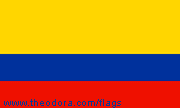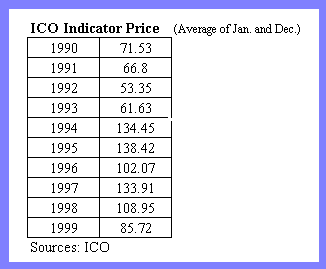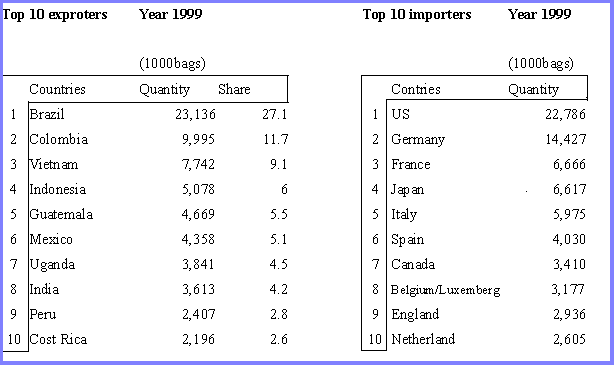
 TOP
TOP

1. The Issue
Coffee is one of the major products in the world, and it is favored by people in all over the world; therefore, it has become the major source of foreign exchange after oil for many developing countries, and it has been sustained their economies. At the same time, it gives a big impact on the world economy, because coffee is one of the important primary products in world trade. Therefore, it supports lives of people who cultivate coffee. However, the price of coffee is very volatile due to the natural causes and supply and demand. Therefore, coffee producing countries established an organization called Association of Coffee Producing Country (ACPC) in addition to the International Coffee Organization (ICO) to maintain stable market. Nevertheless, there still are many obstacles to overcome. Colombia, the 2nd largest coffee producing country, has been coping with this unsettled problem. How is coffee industry in Colombia, and how do they respond to the problem?
2. Description
COLOMBIAN COFFEE
Characteristics
Colombia is the 2nd biggest coffee producer and the biggest producer of Arabica coffee, which is considered the highest quality bean. Cultivation, processing, trading, transportation and marketing of coffee provide employment to many people in Colombia. The major coffee importing countries are the United States, Germany, Japan, Italy and other European countries. There are 570,000 producers. The farmers in Colombia belong to and are controlled by the Colombian Coffee Federation (FNC). The FNC is considered the most successful coffee federation due to over 60 years of experience and continuation of many development activities. The FNC is one of a few organizations that accomplishes to manage farmers. The FNC has been promoting fair-trade, and therefore, it established a system that provided farmers to be able to receive reasonable benefits. As a result, the federation manages the better price in the world market for the lives of those farmers. Moreover, their effort for high quality successfully let Colombia maintain as the 2nd largest coffee provider in the world, and number one in Arabica type coffee. Many Colombian coffee breeds are resistant to crop diseases and unnecessary to use shade trees. The high quality is guaranteed even for the the coffee which is cultivated with shade trees. In recent years, Colombia is enthusiastic about organic coffee that does not use chemical fertilizer or pesticedes. Still, the unpredictable natural calamity such as El Nino and imbalance on demand and supply in the market hit coffee industry in Colombia.
Obstacles
It seems that the biggest problem that Colombia has been facing stems in where it is located. Colombia is located on the Andes, where El Nino and La Nina pass. It takes fairly a long time to recover from such bad weathers. Moreover, Colombia is a country of earthquack situated in the Andes. Earthquack in January 2000 and January 2001 directly hit the coffee growing regions. As a result, infrastructures are destroyed and roads were closed. This led to unavailability of all the process of the production such as fine selection and storage. Consequently, the shippment of coffee beans would be delayed. The best harvest years were the year 1991 and 1992, but since then, the productivity has been decreasing. Furtheremore, the low coffee price in the world market unavoidably has been forcing to lower the price of domestic coffee market. As a result, the FNC cannot stop farmers to lose their confidence on harvesting coffee beans. This could result in farmers to be attracted to the more profitable drug cultivation.
Attempting to Overcome the Obstcles
Consequently, Colombian coffee industry cannot escape from the price fall, and they are groping for a better plan. Currently, the federation manages it by establishing a Coffee Fund. The Coffee Fund is consisted of contribution from both coffee producers and consumers and levying on coffee exports. What is contributed would be reinvested for producers and coffee itself. The fund supports coffee growers by providing domestic minimum price for stable income. The coffee growers are guaranteed the minimum coffee price by covering the difference when the price of Colombian coffee falls in international market. The FNC not only reinvest in coffee, but also reinvest in education, healthcare, electrification, telephone, drainage, and transportation in coffee growing areas for coffee growing farmers. Moreover, the FNC encourages farmers in the coffee regions to grow other crops not to depend too much on coffee. The FNC searches for environmentally friendly coffee growing techniques and technologies such as soil conservation techniques, organic fertilization, safe pest management techniques, wet coffee processing for less water usage, reforestation, and preservation of birds and insects.
WORLD COFFEE MARKET
History
Coffee production is the major industry in many developing countries such as Brazil, Colombia, Indonesia, Mexico, and countries in African and Central America. The coffee market has always been unstable, because of not only natural calamity and supply and demand but also a severe attack by speculators. Since 1945, responsibility was required also to the importing countries than exporters. Importers often agreed to buy coffee with higher price than market price. Coffee producing countries are instead limited the amount of coffee exported. In 1963, the International Coffee Organization (ICO) was established for the purpose of stabilizing coffee market. ICO applied different types of quota systems that were appropriate for the situation at the time. Because of trade liberalization in 1989, the regulations for raw coffee beans were abolished. The coffee producing countries are satisfied with the trade liberalization, and they are eager to explore their new trading partners. Moreover, the producing countries in Asia, Africa, and Central and South America established a cartel called the Association of Coffee Producing Countries (ACPC) in 1993 to restore equilibrium in a certain extent in the coffee market. The objective of ACPC is to stabilize the supply and demand balance in the market and control balance of power. ACPC operates like OPEC.
Agony of Coffee Exporting Countries
Most countries rely heavily on this product as the major source of trade income. ACPC members agreed on a policy, in which they set export quotas to reinforce the management of coffee supply. However, the member countries such as Brazil broke it because of the drastic price hike in 1997. Moreover, Vietnam, which is not a member of ACPC, started to gain the share in coffee market. This could lead to weakening of the power of ACPC. It also signifies that traditional coffee producing countries are threatened of taking over the share and in danger of industry dying out. Furthermore, they are under pressure from the developed countries to follow the theory of sustainable development: protect both environment and labor. Unlike oil, coffee cannot easily change the quantity of production other than increasing stocks. It has been the pattern for coffee producing countries that first they suffer from low price derived from overproduction; then sharp price hike follows due to frost damage or drought in Brazil, the biggest coffee producer. A case in recent years was a great frost damage in Brazil in 1994. The decreasing stock of coffee due to strong world coffee demand attracted speculators, which triggered the skyrocketing of coffee price. However, coffee demand has been increasing because of improvement in quality as a result of liberalization. Simultaneously, domestic demand in these countries has been increasing, which could lead to the scarcity of coffeein world market. Another recent worry is El Nino phenomena. Its effect on coffee cultivation is not yet elucidated, but it is certainly a fear to fluctuate the coffee market.
Coffee Importing Countries
The major coffee importing countries are the United States, Germany, Japan, Italy and other European countries. Since the coffee price has been unstable and unpredictable, the coffee stock in the coffee importing countries has been increasing along with certain import condition. That is, they have always been ready to deal with poor harvest.
The Plan 2000
To deal with this instability resulting from the above mentioned issues, ACPC implemented a plan called The Coffee Retention Plan 2000 to reduce volatility in the market and maintain the proportion of coffee exports. Revival of the plan to hold more stocks did not give much impact on the market, but the plan further accelated the price fall. As mentioned before, The effectiveness of ACPC has not been strengthened since major coffee producing countries such as Vietnam and Mexico were out of the aggrement of this plan. Vietnam has been drastically increasing the productivity of coffee, and Mexico has not been able to join the organization considering the relationship with the United States, the biggest buyer of Mexican coffee, in addition to a plan to increase the productivity. The one of the reasons why nonmembers join the ACPC is that they hesitate to provide funds for both ACPC and ICO. However, the stock accumulation is the only feasible strategy they coud come up with. This plan would be meaningless unless all member countires keep the agreement. Therefore, their cooperation is at least indispensable for the plan to be effective. The dispute over price limitation between ACPC and ICO, which is the dispute between coffee producing countries and coffee consuming countries, had been broken off for almost a decade. Low price of coffee exposes the lives of coffee cultivators to danger. However, the issue of controlling only the low price has brought out the question of international aid, because high price keeps consumers away from buying coffee, which also results in hurting many people's lives in developing countries. There is also a problem that the biggest consuming country, the United States, does not participate in the ICO. The absence of the United States makes whole important conference and decision meaningless.
Present Situation
The price of coffee has recently been dropping drastically. According to ICO, the average annual coffee price has been dropping constantly every year from 108.95 in 1998, 85.72 in 1999, and 64.25 in 2000 to around 49.00 for the first 3 months in 2001. This price fall is a result from excessive supply. Although coffee consumption has gradually been increasing, aggregate supply exceeded aggregate demand due to increasing production in countries like Vietnam. Productivity almost doubled from 6 million bags in 1998 to 11 million bags in 1999 in Vietnam. Ultimately Vietnam has become the number one in productivity in recent months. Vietnam has drastically increased the production since last November. It is even harder to predict the world coffee productivity with unpredicted weather and the competition with new comers.
It is a crutical issue for coffee producing countries to overcome the price volatility, because they have limited capital, unstable profits, countries' bad economic conditions and limited capital for new technology or reseach on coffee. Therefore, it is essential for them to establish firm farmers based organizations like FNC in Colombia.
3. Related Cases
4. Author and Date:
May 9, 2001
 II. Legal Clusters
II. Legal Clusters 
5. Discourse and Status:
Discourse: Agreement
Status: In progress
International Coffee Agreement 2001(ICA 2001)
The International Coffee Agreement 2001 was agreed in September 2000 by 63 member countries and it will hopefully be effective on October 2001. This agreement encourages memeber countries to promote sustainable coffee economy, coffee consumption, quality of coffee, training and information programs, and other objectives.
6. Forum and Scope:
Forum: The International Coffee Organization (ICO) : 45 exporting countries and 18 importing countries
and Association of Coffee Producing Countries (ACPC) : 14 ratified countries and 14 more signatory countries
Scope: Multilateral
7. Decision Breadth:
Coffee producing countries are affected especially by this with very volitile market.
8. Legal Standing: Treaty
Colombia maintains a high quality control standards. Strict inspection by the FNC to each farms is made for better quality. The inspectors check the size, color, and quality of coffee beans. The inspectors give the permission to farmers for shipping. Not only the inspectors but also the operation's owners check the quality of coffee beans. The best beans are selected for export. There are different level of inspections until coffeet is finally shipped for export.
 III. Geographic Clusters
III. Geographic Clusters9. Geographic Locations
b. Geographic Site: West South America
c. Geographic Impact: Colombia
10. Sub-National Factors: No
11. Type of Habitat:
 IV. Trade Clusters
IV. Trade Clusters12. Type of Measure: Tariff and quota
As an example of measurement, Japan regulates coffee import by tariff. The level of tariff varies by the form. For the raw coffee bean, there is no tariff imposed since the trade liberalization in 1989. However, the processed coffee are imposed a certain degree of tariffs. Furthermore, preferential tariffs (0%) are provided to the least developed coffee producing countries.
13. Direct v. Indirect Impacts:
Indirect impact on Colombian coffee industry
14. Relation of Trade Measure to Environmental Impact
b. Indirectly Related to Product: No
c. Not Related to Product: No
d. Related to Process: Habitat change
15. Trade Product Identification:
Product: Coffee
16. Economic Data
| 000's bags | 1992/93 | 1993/94 | 1994/95 | 1995/96 | 1996/97 | 1997/98 |
|---|---|---|---|---|---|---|
| Total Production | 13,823 | 11,320 | 12,989 | 12,878 | 10,876 | 12,211 |
| Domestic Consumption | 1,300 | 1,400 | 1,375 | 1,500 | 1,600 | 1,600 |
The lack of rain and insect damage caused low productivity in 1997, but the productivitiy increased in 1998 due to a long period of rain while they had problems maintaining the good quality resulting from high humidity. The best harvest years in the last decade are 1991 and 1992. The production amounted to over 16 million bags.

17. Impact of Trade Restriction:
As to the WTO legal issue, with respect to agricultural goods, Colombia, as a member of the Cairns Group, was an active participant in the Uruguay Round negotiations in this area. The Cairns Group is composed of 15 agriculture exporting countries, who has been asserting the complete free trade on agriculture. Colombia's commitments in the agricultural sector represent an average tariff reduction of 24% over a decade period. In addition, Colombia committed itself to limit agricultural subsidies and agricultural export promotion programs.
18. Industry Sector: Food (Agriculture)
19. Exporters and Importers: Exporters
The biggest Colombian coffee importer is the United States followed by Germany and Japan and other European countries
The Colombian coffee is favored by many people in the United States.

 V. Environment Clusters
V. Environment Clusters20. Environmental Problem Type:
Coffee plays an important role in the tropical Andean ecosystem. The Colombian Coffee Federation is working toward a sustainable ecosystem, which delivered a conservation biology program. The fund supports a certain level of coffee production, environmental protection, and cofee growers. Because Colombian coffee is cultivated from 1000 to 2000 meter of elevation, most serious problem is that water running over the surface of the coffee growing regions cause the soil erosion. It eventually leads to the reduction of productivity and increase of expenditures on fertilizer to maintain productivity. Colombia tries to diversify the region and avoid the monoproduction. They try not to increase the total area planted in coffee. The coffee area is harmonized with other crops and forests and pastures. Therefore, this diversified landscape also let coffee producers move towards environmentally friendly cultivation. Small-sized farmers produce 76% of coffee, because small farm size provides heterogeneity of the landscape. Colombia tries to be able to coexist with the abundant nature surrounded. Especially, avian species are found in coffee growing areas. Many migratory birds in the coffee regions come from the United States and Canada. Moreover, rare Colombian endemic species are found in shade coffee farms. Therefore, heterogeneous coffee growing landscape supports a diverse biosystem.
21. Name, Type, and Diversity of Species
There are also migratory species such as Olive-sided Ayoatcher, Tennessee Warbler, Yellow Warbler, Baybreasted Warbler, Cerulean Warbler, Canada Warbler
22. Resource Impact and Effect:
Effect: Large
23. Urgency and Lifetime: Low and 100s of years
Since the Colombian Coffee Federation is commited strongly on sustainable development with innovation of new technology, which provide the minimum impact on environment, I believe that there is no real threat of changing ecosystem.
24. Substitutes: Tea !
 VI. Other Factors
VI. Other Factors25. Culture:
Colombia is a country with earthquake. In January 25,2001, the major earthquake hit the coffee-growing regions in Colombia. Because of it, farmers in Armenia and Pereira lost everything. They need emergency shelter, food and medical care. Furthermore, they need to rebuild house, schools, health care facilities, aqua ducts, coffee-processing facilities, roads and bridges. Because they totally rely on coffee cultivation for their source of income, it seriously affects their lives. To cope with it, Colombian Relief Fund is incorporated to provide humanitarian assistance.
26. Trans-Boundary Issues: No
27. Rights: No
28. Relevant Literature
All Japan Coffee Association. Zenkyo Kaigai Joho (International Coffee Affairs) Vol. 100 June 2000.
The Colombian Coffee Federation,http://www.askjuan.com
International Coffee Organization,http://www.ico.org/
National Federation of Coffee Growers of Colombia, http://www.juanvaldez.com/
All Japan Coffee Association,http://coffee.ajca.or.jp/
Association of Coffee Producing Countries, http://www.acpc.org
Graphics
Angelique Web Graphic Materials, http://www.miyuweb.com/angel/
Studio Media: Independent Art Office, http://www06.u-page.so-net.ne.jp/
Silicon Cafe.com for homepage, http://www.siliconcafe.com/gtool/data/text/02/but05_01.html
Flags courtesy of www.theodora.com/flags used with permission, http://www.theodora.com/flags